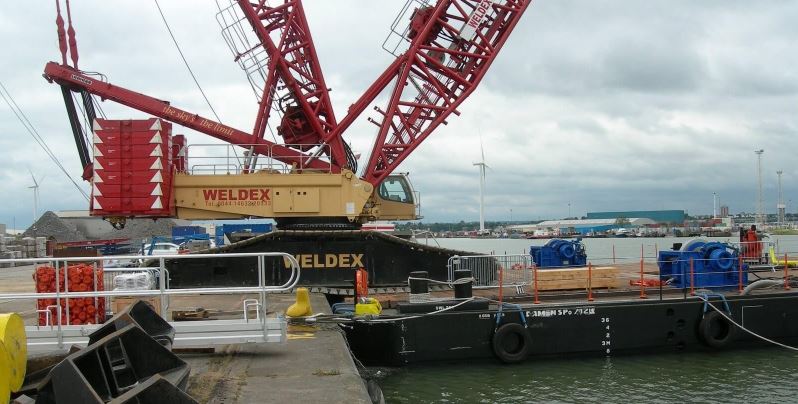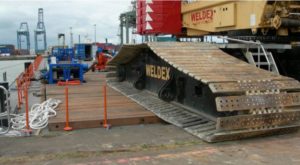DSB Offshore and DAMEN Shipyards work together with Thames Tideway
News
The Ferrovial Agroman Laing O’Rourke joint venture (FLO) has taken delivery of two Damen Stan Pontoons.
The barges were sold via London-based shipbrokers DSB Offshore: “The team at DSB mediated a large part of this deal – including a visit to view the vessels in the Netherlands,” Mr Van Elk notes. “We would like to thank them for their cooperative involvement.”
FLO will deploy the vessels – a SPo 7120 and a SPo 4113 – for marine infrastructure construction duties on the Thames Tideway Tunnel project in London. The joint venture company has also chartered a smaller SPo 3011 for a period of one year. Considered to be one of the most important civil engineering projects currently under construction. The Thames Tideway Tunnel represents the modernisation of London’s subterranean sewage system. Totalling more than 25 km in length, the tunnel will carry London’s sewage to treatment works east of the city.
The FLO joint venture will construct the central section of the tunnel, which, measuring almost 13 km, is the longest section of the whole project.
In preparation for the principal tunnelling operations, FLO will construct a number of cofferdams in Chelsea, Victoria, Blackfriars and Albert Embankment. Further works are located in Kirtling Street, Heathwall, Cremorne, Tilbury, Cliffe and Northfleet.
“We are building ten marine sites for this project, and in order to facilitate the delivery of these sites, we will need a combination of crane barges and flat top transport and supply barges,” says Mike Toulson, Senior Project Manager for the FLO joint venture.
The versatility of Damen’s Stan Pontoon design means the two purchased vessels will be able to perform both aspects of this work. “We will initially use these two barges as crane barges for the delivery of facilities at East Tilbury, Victoria, and Blackfriars.” To this end, FLO is currently installing a 600-tonne crane onto the deck of the Stan Pontoon 7120, and a 250-tonne crane onto the Stan Pontoon 4113, ready for mobilisation in August.
“Then we will convert them back to flat top transport barges for the delivery of the additional river sites. They will be used to transport the sheet piles, tubular piles, tie bars and other structural steelwork used in the construction of cofferdams and jetties.”
Long-term programme
As the Thames Tideway Tunnel progresses, the true scale of the works will come to light. An estimated 1.6 million tonnes of tunnel spoil will be exported from the Kirtling Street site alone.
As the project nears completion (expected in 2024), FLO will be required to remove all the temporary marine infrastructure. At this time, the joint venture will convert the pontoons back into crane barges once again.
“These vessels were the right size and the right fit for this project – fulfilling our long-term requirements. And the fast delivery was perfect for us and our programme requirements,” Mr Toulson adds.
Shortly after delivery in June 2017, the two Stan Pontoons were named and registered under the UK Flag. The 71-metre Pontoon was named TTT 7120, and the 41-metre Pontoon was named TTT 4113.
Reflecting the financial intricacies of vessel acquisition for project-based contracts, FLO has chartered a third vessel – a Stan Pontoon 3011 – from Damen for a 12-month duration. During this time, this vessel will undertake crane barge activities at the Victoria site.
Changing client needs
“For both the sold and chartered vessels, we are proud that these Damen pontoons will be contributing to the success of this major urban infrastructure project,” states Damen Sales Manager UK & Ireland Arjen van Elk.
“The adaptability of our Stan Pontoon makes it an ideal platform for FLO’s changing requirements over this long-term project. And, of course, having the vessels on stock, ready for delivery, means that operations can start as quickly as possible.”
For the sale of these two Stan Pontoons, the business contact between Damen and FLO was facilitated by London-based shipbrokers DSB Offshore. “The team at DSB mediated a large part of this deal – including a visit to view the vessels in the Netherlands,” Mr Van Elk notes. “We would like to thank them for their cooperative involvement.”
Source: This article was published by DAMEN shipyards
